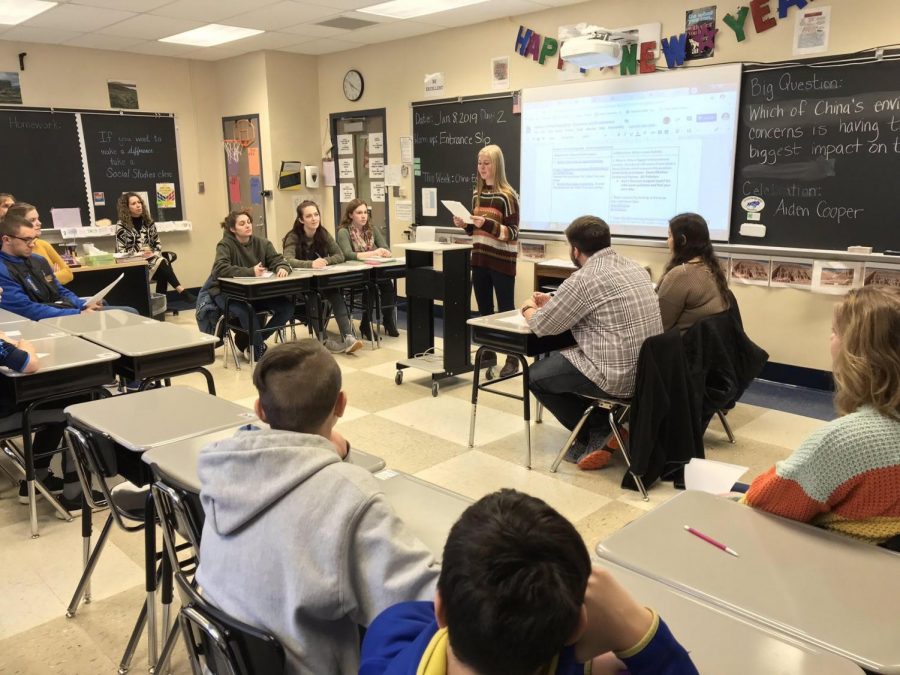Argument Class Shows Middle Schoolers how to Debate
January 15, 2019
On January 8, the high school Argument class offered through the University of Pittsburgh went to the middle school in order to debate in front of social studies teacher Angie Chilcoat’s class.
Argument is a class that teaches students about proper public speaking and debate format.
Chilcoat plans to have the students in her class do some debates and thought it would be very beneficial for her students to see high school students perform a proper debate.
Argument teacher Grant Leonard agreed and set his students to working on preparing for the debates.
Leonard planned for two debates to take place to display both of the major debate styles that he had taught his students so far: Lincoln-Douglas debate and Public Forum debate.
Lincoln-Douglas debate is a debate in which the affirmative (those in favor of the topic) speaks first and gets to speak last with a constructive, rebuttal, and a closing rebuttal, and the negative (the side that opposes the topic) has constructive and a rebuttal, but both sides speak for the same amount of time and there is a cross examination after each constructive.
The Public Forum Debate is a debate in which you can pick either the side you want to argue or you can choose to have last word, this means that neither the affirmative nor the negative are guaranteed first or last word. This debate consists of a constructive, rebuttal, summary, and final focus for each team, two crossfires, and a grand crossfire.
Each debate was shortened for the sake of time at the middle school.
The first debate was the Lincoln-Douglas style with the resolution: Students are too dependent on technology. The debaters were seniors Jenna Kandeel, Colleen Nersten, Jamie Smith, Adam Steiner, Julia Wecker, and junior Teresa Rose.
Kandeel, Nersten, and Steiner were the affirmative, so they argued that students are too dependent on technology and their three contentions (major points) were: students spend a majority of their time on technology, students lacked social skills they were once forced to learn, and technology encourages laziness and promotes instant gratification.
Rose, Smith, and Wecker were the negative, so they argued that students are not too dependent on technology and their three contentions were: Students are not dependent on technology because they need it, it allows for the better sharing of ideas, and it prepares people for their future.
After returning to the school, Leonard informed his students that the affirmative team won because the affirmative made better points and more successfully defended them.
After the Lincoln-Douglas style was finished, the Public Forum debate went with the resolution: We should fear alien lifeforms. The debaters were seniors Jonathan Brown, Autumn Smith, Maddie Warfield, and junior Hannah Miner.
Brown and Smith were the negative, so they argued that we should not fear alien lifeforms. The negative spoke first in this debate, and their three contentions were: There is no credible evidence that aliens definitely exist, fear stunts progress, and blind fear promotes prejudice and discrimination.
Miner and Warfield were the affirmative, so they argued that we should fear alien lifeforms, and their three contentions were: they’re the world’s greatest fear, aliens could be more advanced than us and that could be dangerous, and aliens could be controlling us at this very moment.
There has not been an announced winner for this debate yet because Leonard has yet to decide.
When both debates were over, the middle school students had to write either what they learned or who they believed won each debate.
Reflecting on the experience after the fact, Nersten felt proud, stating, “It was awesome for us because it was the first time we had a decent sized audience, and it appeared to be interesting for them, as it was the first time they were exposed to formal debates. [Overall,] both groups benefited and we had a lot of fun.


